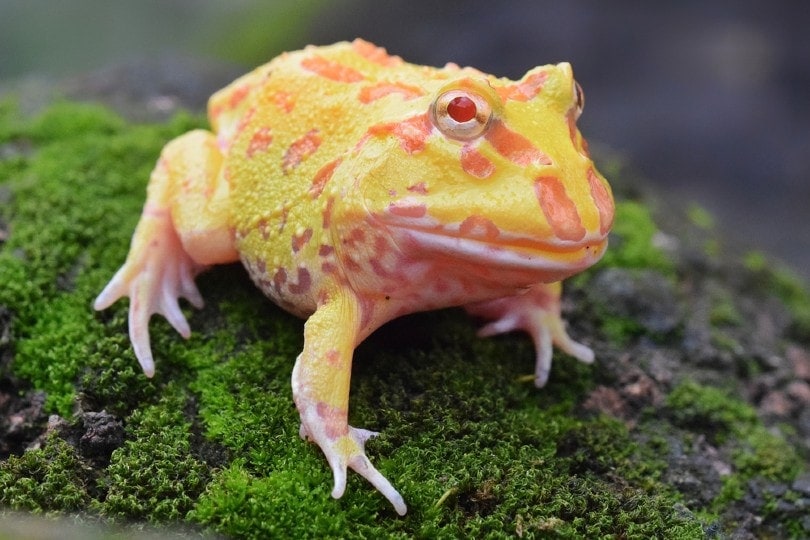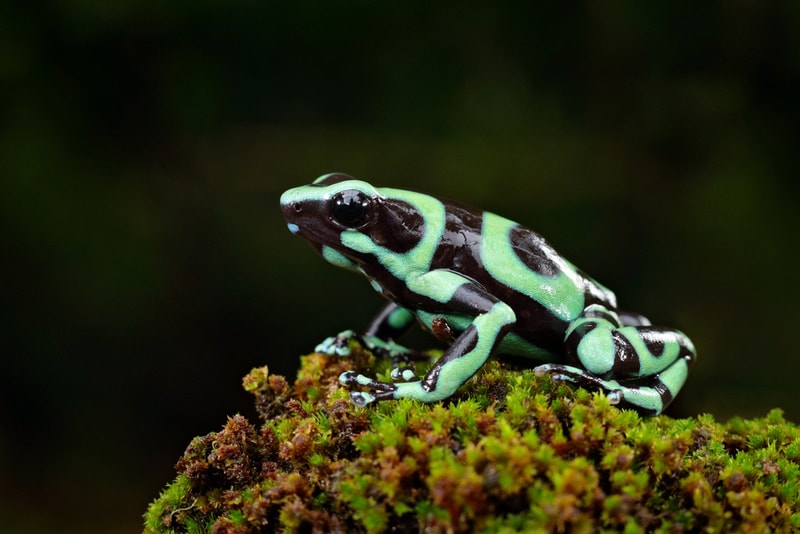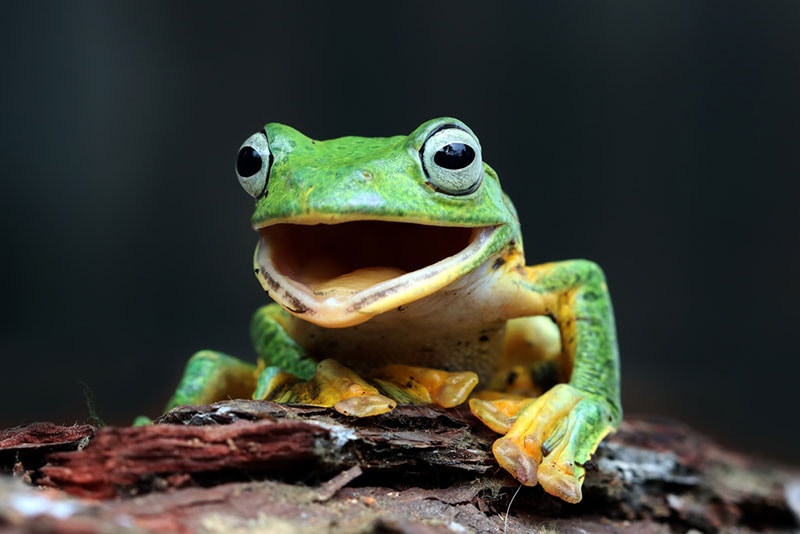Is a Frog an Herbivore, Carnivore or Omnivore? Vet Approved Facts & FAQ
By Ashley Bates
Updated on
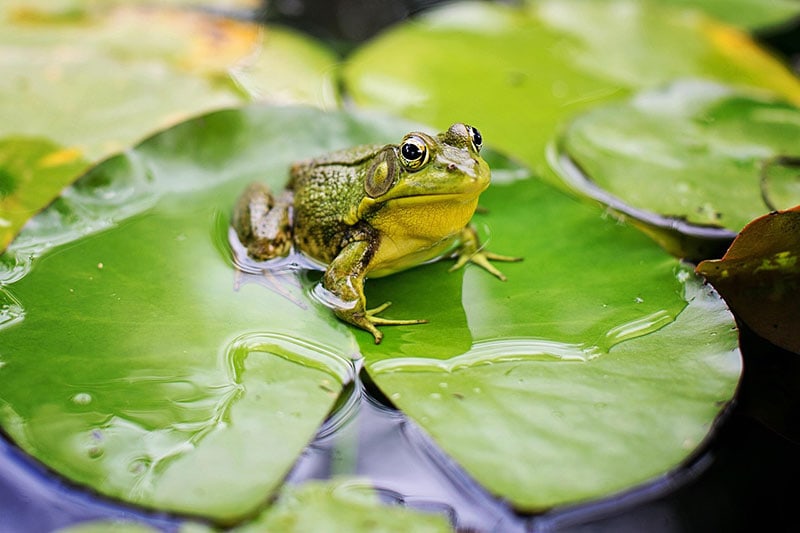
Frogs are extraordinary creatures! All frog species have their own way of operating. They can be brightly colored to warn predators or camouflaged to suit their environment. They can sing, climb trees, live underwater—there are so many variations!
Because frogs are plentiful and vastly different from one another, you might be curious about what kind of diet they have. Are all frogs different? Or are they unanimously herbivores, carnivores, or omnivores? The answer is a little complex—but nearly all adult frogs are 100% carnivorous. Let’s hash out the details.
Tadpoles & Froglets: A Plant-Based Diet
Frogs form as eggs first. The smaller male frogs climb atop a willing female in shallow water areas. The female will then lay up to hundreds of eggs from the stimulation! After the female drops the clutch, the male fertilizes these eggs. Tadpoles then emerge in roughly 3 weeks, depending on the temperature of the water.
At first, tadpoles feed off the yolk that stays with them, but this quickly runs out, and they seek a food supply. In the wild, tadpoles eat pond weeds and algae. This is the only time in their entire development they will be vegetarian.
If tadpoles are in captivity, you can feed them things like lettuce to munch on for the first few weeks. Tadpoles in the wild generally only need supplementation if the pond or water source is new or depleted of vital nutrients.

A Tadpoles Diet Changes Throughout Development
For a brief moment, around 6 weeks old, tadpoles will switch from eating pond algae to insects. They typically start eating pond fleas and other small insects but quickly move on to juicier, meatier insects. Once the transition ultimately starts, they will only feed on insects after this point.
Sometimes, frogs might accidentally ingest plant matter when they are hunting for insects. It is not unusual for them to mistakenly get a piece of a leaf, blade of grass, or flower petal while latching on to prey. This stage of metamorphosis is called herbivory, and it only happens during the larval stages.
Adult Frogs Are Obligate Carnivores
All adult frogs love one thing and one only—delicious bugs. So, they play a vital role to our environment, preventing the planet from being overrun with creepy, crawly critters. On average, one frog consumes up to 100 insects in one day.
On land, frogs will eat just about any insect in their tongue’s reach. They prefer meaty insects like grasshoppers, flies, crickets, and locusts. But they also feast on worms, slugs, snails, and grubs.
Frogs can grow quite large. Those who get more significant than most, such as bullfrogs, can eat even bigger game—like small birds, bats, lizards, turtles, salamanders, and mice on land. In turn, they are also eaten by small animals, too—even the same ones they consume sometimes. It’s give-and-take in nature.
In the water, they will feast on minnows, goldfish, guppies, and other fish. They are very aggressive hunters, quickly consuming anything they can when the moment strikes.
Even in captivity, most frogs only eat live prey, so buying them a sack of crickets or mealworms is crucial to satisfy their hunger.
Are Any Live Foods Toxic to Frogs?
If you have a frog as a pet, always avoid feeding them any wild bugs because they can carry parasites, herbicides, and pesticides in their system. Toxic insects for frogs include ladybugs, stink bugs, praying mantises, and millipedes.
Most live foods that are toxic to frogs aren’t going to be a problem, though. Frogs are very good about knowing what is and isn’t good for them, and they have an exquisite sense of smell. If they can sense that an insect isn’t that appetizing, they can avoid it.
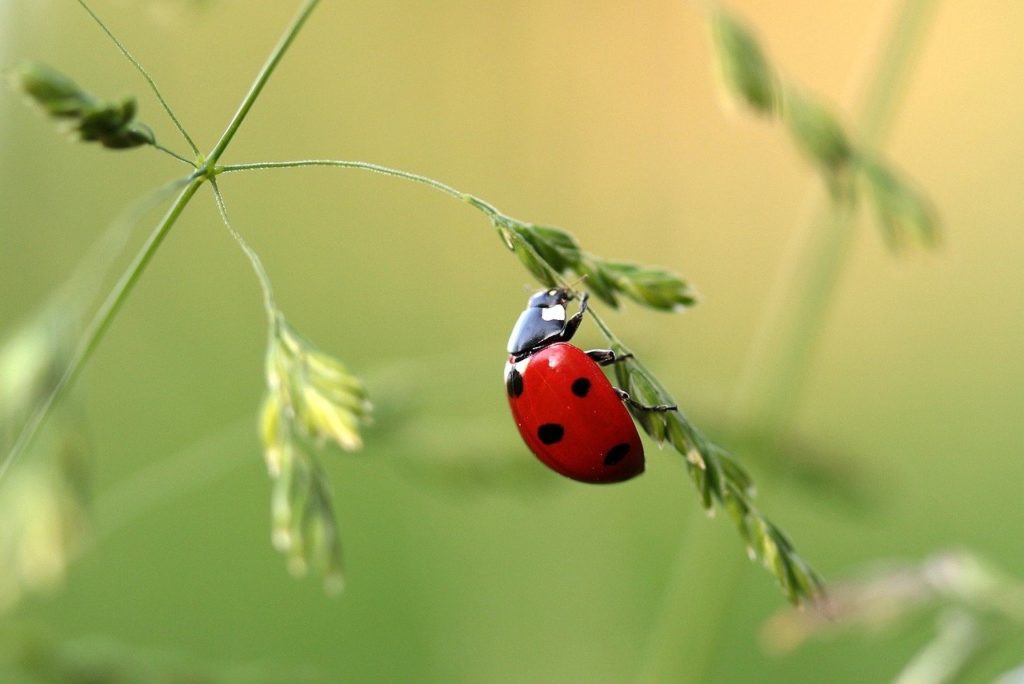
Some Insects Kill Frogs
Oh, how the tables turn. What happens when the predator falls victim to its food supply? Some giant water bugs will actually kill and consume frogs rather than the opposite. What’s interesting about them is that they typically seek out larger frogs rather than smaller frogs.
Giant water bugs, or Lethocerus americanus, are over 2 inches long and live in ponds and lakes. They kill prey by injecting venom—and frogs are not their only target. Often, they target Pacific chorus frogs or Pacific tree frogs.
Three different species of water bugs live in North America. Depending on where you fall on the map, these bugs are much more likely to invade your waters.
In addition to giant water bugs, it is common for wild dragonflies to eat tadpoles and even small frogs. They have been known to zip out of the water and attack tree frogs. However, they generally feast more on other flying insects.
Did You Know Frogs Are Cannibals?
As sadistic as it might sound to us, eating their own kind is commonplace for frogs. If prey presents itself and it’s small enough to eat, they have no problem digesting one of their own. It’s very typical for frogs to eat juveniles, like tadpoles.
They can detect other frogs by listening to their calls. Once they spot them, they can target the prey easily. For example, invasive frog species, like the bullfrog, are more likely to cannibalize than non-invasive species.
However, when food sources are low, anything is possible to maintain survival. Frogs are also opportunistic eaters that aren’t picky. If you’re nearby and something is the correct size, it’s fair game to these amphibians.
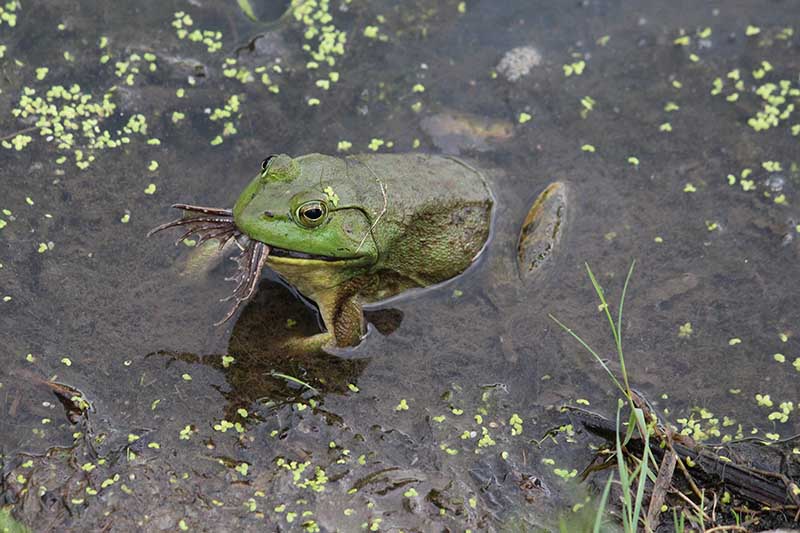
Are Any Frogs Completely Herbivorous As Adults?
An herbivorous frog? That sounds absurd! But evolution says we’ll pick one to defy the odds! At first glance, this frog might look rather unremarkable, but Izecksohn’s Brazilian tree frog is a frugivorous tree frog in the family Hylidae. It can be found in Rio de Janeiro, Brazil, along with many other remarkable animals.
This frog is so unique that it is the single, only, solo, numero uno, non-carnivorous frog in the world! The term frugivorous means they rely on fruit and fruit only for sustenance. They have an interesting way of eating, unlike any other frog species to exist.
Not only do these frogs have an exciting way of living, they also really help the environment. This tree frog will locate fruit, snap it, and eat it whole. They later defecate viable seeds out and spread the plants across the territory. This act allows new, fresh fruit to form eventually.
What Happens If You Feed a Frog Plants
If you have a pet frog and decide to try to feed it plants anyway, this is a surefire path to eventual death. They need a rich protein source that only insects can provide. Vegetation does not support a frog’s bodily systems in any way.
If you have a pet frog, you must stay away from any kind of vegetation, even if your insect stash is running low.
Also, frogs aren’t eaters of carrion. They will almost always consume live insects or small mammals, but nothing dead for any time. So, in captivity, many dried crickets and mealworms won’t suffice. You may notice that your frog is acting utterly disinterested in these items.
Breeding Insects for Pet Frogs
If you have a frog at home and want ways to ensure a constant food source, you could try your hand at breeding insects. Mealworms and crickets are two very easy and super accessible insects to start with. They provide a scrumptious protein source for your frogs, too.
If you have a few unused containers lying around, you should be able to whip up a nice habitat for these juicy insects. It is a great way to continue a food supply without constantly repurchasing.
Frogs Are Great to Have In Your Garden
If you have a garden, frogs and toads are excellent plant additions. Instead of feeding on your vegetation, they work to protect your growth by eating any pests that might be lingering around.
In fact, most people try to attract toads and frogs to their gardens for this reason. They are incredibly beneficial to the natural ecosystem they’re in and can really cut down on leaf damage.
So, if you want to attract these amphibians to your garden space, try to build rock piles, border the garden with dense, native perennials, and leave leaf litter around if you can. This attracts some nice hiding spots for frogs and toads and welcomes the prey they love to feast on.

Importance of Avoiding Dietary Misinformation
It is absolutely imperative that we learn as much accurate information as possible when we are responsible for the care of another life—no matter how small they might be. There is some frustrating misinformation out there on the web.
Lack of truth can cause major mishaps if you’re caring for wildlife or welcome an exotic animal as a pet. So, if you’ve read that frogs can eat vegetation as adults, don’t use this source of information. It is not accurate information and can cause the sickness or death of your beloved pet.
Always look for credible websites to validate any information you get. When in doubt, consult professionals or exotic veterinarians to discuss nutrition for your domestic frog.
Frogs + Herbivores: That’s a No
So, now you know that apart from tadpoles and Izecksohn’s Brazilian tree frogs, frogs do not eat any plant material. Adults much prefer delicious insects—particularly spiders, grasshoppers, butterflies, mosquitos, and gnats.
Frogs are quite opportunistic and can eat several insects a day. Obviously, some days will be more filling than others. However, if you have a frog in a domestic setting, always follow specific feeding guidelines based on its life stage, species, and weight.
See Also:
Featured Image Credit: JillWellington, Pixabay


